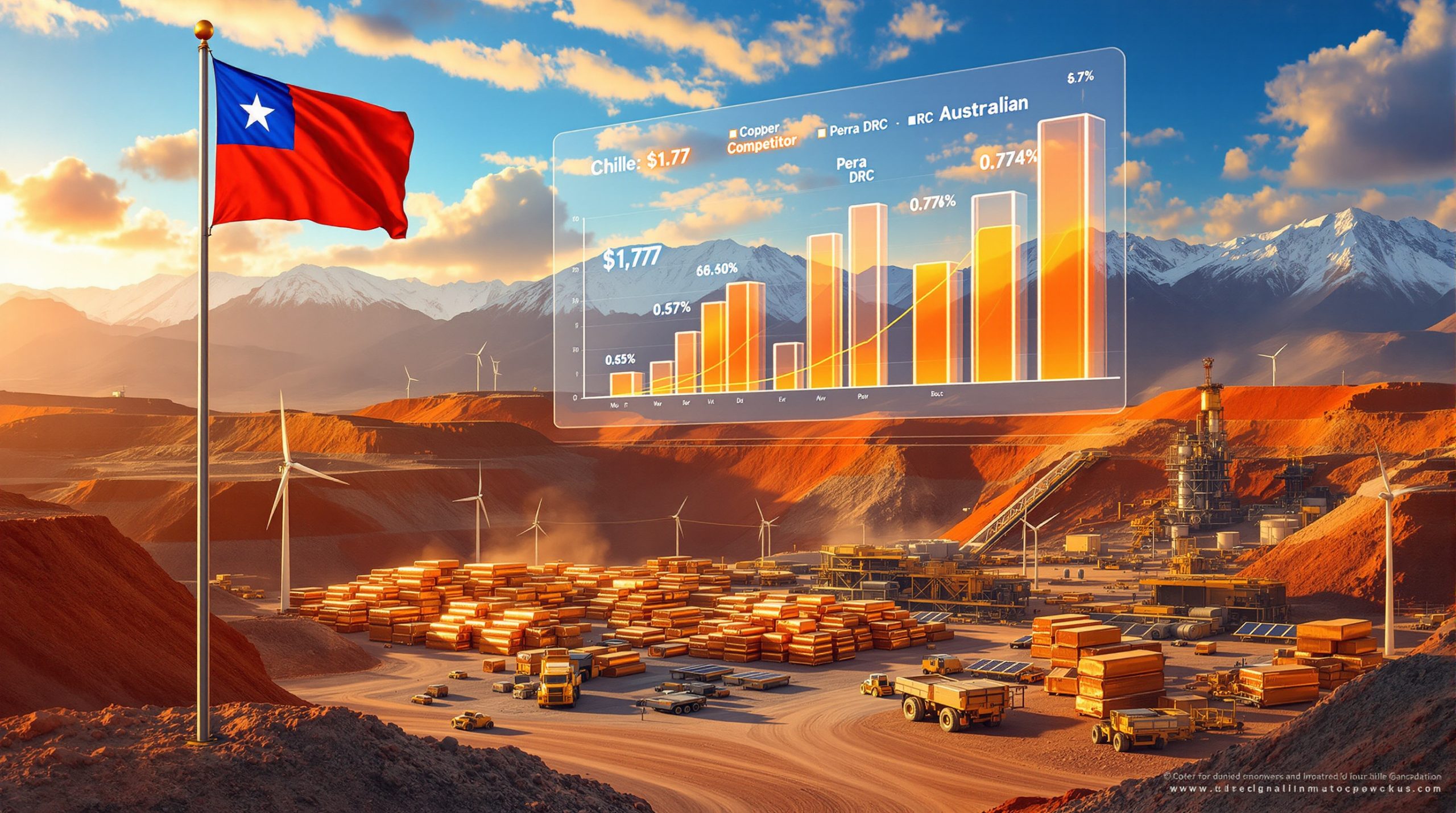Cross-border environmental assessment represents a sophisticated evaluation framework designed to analyze environmental impacts that extend beyond national boundaries. This process becomes increasingly critical as mining projects span multiple jurisdictions, requiring coordinated regulatory oversight and comprehensive stakeholder engagement across different legal systems. The Kon Kweni cross-border environmental assessment demonstrates how modern mining operations must navigate intricate multi-jurisdictional requirements to achieve regulatory compliance and community acceptance.
The complexity of transboundary environmental review stems from the need to harmonise diverse regulatory frameworks while maintaining each nation's sovereignty over environmental protection standards. Projects like the Kon Kweni iron-ore development, which spans Guinea and Liberia, demonstrate how modern mining industry innovation must navigate intricate multi-jurisdictional requirements to achieve regulatory compliance and community acceptance.
Key Components of International Environmental Impact Studies
Effective cross-border environmental assessments require several interconnected components working in harmony. The regulatory coordination framework establishes standardised procedures between participating nations, enabling consistent data collection methodologies and joint review processes. This coordination proves essential when projects affect shared ecosystems or generate cumulative impacts across political boundaries.
Stakeholder engagement requirements become particularly complex in transboundary contexts, necessitating culturally appropriate consultation processes that respect diverse community structures and traditional governance systems. The Kon Kweni cross-border environmental assessment exemplifies this approach through its multi-year baseline studies encompassing social, biophysical, and biodiversity assessments across both Guinea and Liberia.
International expert review panels provide technical oversight and ensure assessment methodologies meet global best practice standards. These panels often include specialists in regional ecology, hydrology, and social impact assessment who can evaluate cumulative effects across multiple jurisdictions effectively.
How Do Cross-Border Projects Navigate Complex Regulatory Landscapes?
Multi-Jurisdictional Compliance Challenges
Navigating regulatory landscapes across international boundaries requires sophisticated project management strategies that address varying legal requirements, approval timelines, and permitting processes simultaneously. Furthermore, the Kon Kweni cross-border environmental assessment demonstrates this complexity through its dual ESIA approach, with separate assessments covering Phase 1 mining activities in Guinea and infrastructure components in Liberia.
The project's phased development strategy illustrates practical regulatory navigation, with initial production targeting 2 million tonnes annually, ramping to 5 million tonnes, while Phase 2 expansion aims for 30 million tonnes by 2029. This approach allows regulatory authorities in both countries to evaluate impacts incrementally, reducing assessment complexity and enabling adaptive management responses.
Construction timelines reflect regulatory coordination challenges, with the Kon Kweni project targeting Q1 2026 construction commencement following multi-year baseline studies. This extended timeline demonstrates the thoroughness required for cross-border environmental assessment processes that must satisfy diverse regulatory frameworks simultaneously.
International Legal Framework Applications
The Convention on Environmental Impact Assessment in a Transboundary Context establishes fundamental principles for cross-border environmental evaluation, though its application varies globally. Currently encompassing 46 parties, the Convention mandates notification procedures between affected countries, standardised assessment methodologies, and joint monitoring obligations.
However, many cross-border mining projects operate outside formal Convention frameworks, as evidenced by the Kon Kweni development in Guinea and Liberia, neither of which are Convention parties. This situation necessitates bilateral agreements and company-driven best practice standards to ensure comprehensive environmental protection across borders.
Regional frameworks often supplement international conventions, with organisations like the Mano River Union providing cooperation mechanisms for member states including Liberia, Guinea, Sierra Leone, and Côte d'Ivoire. These regional partnerships facilitate coordinated approaches to transboundary environmental challenges while respecting national sovereignty over resource management decisions.
What Environmental Risks Require Cross-Border Assessment?
Ecosystem and Biodiversity Impacts
Transboundary projects frequently affect interconnected ecosystems that span political boundaries, requiring specialised assessment approaches addressing ecological connectivity and species migration patterns. For instance, the Kon Kweni project's multi-year biodiversity baseline studies exemplify comprehensive approaches to understanding ecosystem impacts across Guinea and Liberia's shared landscapes.
Critical assessment areas include habitat fragmentation analysis, particularly important in West Africa's remaining forest ecosystems where mining activities can disrupt wildlife corridors spanning multiple countries. The Mano River Union region encompasses diverse ecological zones requiring careful evaluation of cumulative impacts from industrial development.
Migratory species considerations become paramount in cross-border assessments, as seasonal movement patterns often predate political boundaries. Projects must evaluate disruption risks to species dependent on transboundary habitat networks, requiring coordinated monitoring and mitigation strategies across multiple jurisdictions.
Water Resource and Pollution Concerns
Cross-border mining developments pose significant risks to shared water resources, necessitating comprehensive hydrological assessments addressing both surface and groundwater systems. Iron ore mining operations, such as the Kon Kweni project with projected outputs reaching 30 million tonnes annually in Phase 2, generate substantial water management challenges requiring careful evaluation across national boundaries.
| Impact Category | Assessment Focus | Monitoring Requirements |
|---|---|---|
| Surface Water | Flow modifications, quality changes | Joint water quality monitoring |
| Groundwater | Aquifer depletion, contamination risks | Cross-border groundwater studies |
| Marine Environment | Coastal impacts, shipping effects | Regional marine monitoring |
| Air Quality | Transboundary emissions, acid deposition | Atmospheric monitoring networks |
Tailings management represents a critical concern for cross-border iron ore projects, as mining operations typically generate approximately 2.7 tonnes of tailings per tonne of ore produced. The Kon Kweni project's infrastructure spanning both Guinea and Liberia requires coordinated waste management strategies ensuring environmental protection across both jurisdictions.
How Are Indigenous and Community Rights Protected in Cross-Border Assessments?
Multi-National Community Engagement
Cross-border projects must address complex community structures spanning international boundaries, often encompassing traditional territories that predate modern political divisions. The Kon Kweni project's extensive community engagement processes demonstrate practical approaches to multi-jurisdictional stakeholder consultation, though specific methodologies employed across Guinea and Liberia remain undisclosed in available documentation.
Community protection measures require recognition of traditional territories crossing political boundaries, necessitating culturally appropriate consultation processes that respect indigenous governance systems and customary land tenure arrangements. These processes must accommodate varying legal frameworks while ensuring meaningful participation in project planning and benefit-sharing arrangements.
Traditional resource access rights become particularly complex in cross-border contexts where mining operations may affect customary fishing grounds, agricultural areas, or sacred sites spanning multiple jurisdictions. Consequently, projects must develop compensation mechanisms addressing these diverse community interests while complying with different legal systems' requirements for indigenous rights protection.
Indigenous Rights Considerations
Many transboundary mining regions encompass traditional territories predating current political boundaries, requiring specialised engagement approaches respecting indigenous sovereignty and traditional governance systems. The International Finance Corporation's Performance Standards provide guidance for indigenous peoples' consultation, emphasising free, prior, and informed consent principles applicable across jurisdictions.
Indigenous rights protection in cross-border contexts often requires coordination between different legal frameworks, as countries maintain varying constitutional provisions and legislative protections for indigenous communities. This complexity necessitates comprehensive legal analysis ensuring compliance with the most stringent standards applicable across affected jurisdictions.
What Role Do International Organisations Play in Cross-Border Environmental Assessment?
UNESCO World Heritage Site Protections
When cross-border projects affect UNESCO World Heritage sites or buffer zones, additional international oversight mechanisms activate, requiring World Heritage Committee consultation and Outstanding Universal Value impact assessments. These processes involve international expert review panels and enhanced monitoring requirements extending beyond national regulatory frameworks.
The West African region encompasses several transboundary conservation areas requiring specialised assessment approaches when mining development occurs nearby. Projects must demonstrate compatibility with conservation objectives while contributing to regional sustainable development goals through coordinated international cooperation mechanisms.
Regional Environmental Bodies
The Economic Community of West African States provides environmental policy frameworks affecting member states including Guinea and Liberia. ECOWAS environmental protocols establish regional standards for impact assessment and cross-border cooperation, though specific implementation mechanisms vary among member countries.
The Mano River Union itself functions as a regional organisation facilitating cooperation between Liberia, Guinea, Sierra Leone, and Côte d'Ivoire on shared challenges including environmental management and economic development. This regional framework provides institutional mechanisms supporting coordinated approaches to transboundary environmental assessment.
In addition, the African Union's environmental protocols, including the African Convention on Nature and Natural Resources, establish continental frameworks for environmental protection and cooperation. These instruments provide overarching principles applicable to cross-border mining developments while allowing regional adaptation to specific ecological and cultural contexts.
How Do Companies Manage Cross-Border Environmental Assessment Processes?
Integrated Project Planning Strategies
Successful cross-border mining developments require sophisticated planning approaches addressing multiple regulatory systems while maintaining project viability and construction timelines. The Kon Kweni cross-border environmental assessment demonstrates integrated planning through its dual ESIA strategy, with coordinated submissions addressing Guinea's mining components and Liberia's infrastructure requirements as unified project elements.
The project's phased development approach illustrates strategic risk management, beginning with 2-5 million tonnes annual production in Phase 1 before expanding to 30 million tonnes in Phase 2. This incremental approach enables regulatory authorities to evaluate actual project performance before approving expanded operations, reducing assessment uncertainty and building stakeholder confidence.
In-country teams and assessment partners represent essential components of successful cross-border project management. Ivanhoe Atlantic's comprehensive environmental studies for the Kon Kweni development's emphasis on local partnerships demonstrates recognition that effective environmental assessment requires deep understanding of regional ecological conditions, community structures, and regulatory processes in each affected jurisdiction.
Risk Management and Mitigation
Cross-border projects face amplified risks due to regulatory complexity, currency fluctuations, and political considerations spanning multiple countries. However, effective risk management requires comprehensive assessment of potential impacts across different legal systems while developing mitigation strategies acceptable to all regulatory authorities involved.
"Companies must establish dedicated cross-border coordination teams with expertise in multiple regulatory systems and strong relationships with authorities in all affected jurisdictions to navigate complex approval processes successfully."
The Kon Kweni project's targeting of US critical mineral supply chains demonstrates strategic risk mitigation through alignment with broader geopolitical objectives supporting project sustainability. This approach potentially reduces regulatory and financing risks while enhancing long-term operational security across both Guinea and Liberia.
What Are the Economic Implications of Cross-Border Environmental Assessment?
Cost-Benefit Analysis Complexities
Cross-border environmental assessments require sophisticated economic analysis accounting for multiple currency systems, varying labour costs, and different regulatory fee structures across affected jurisdictions. The Kon Kweni project's projected contribution to both Guinean and Liberian economies illustrates complex benefit distribution mechanisms requiring careful economic modelling and stakeholder negotiation.
Assessment costs for comprehensive cross-border ESIAs typically range between USD 500,000 to USD 3,000,000 depending on project scale and geographic complexity. These expenditures represent essential investments in regulatory compliance and community acceptance, though they add significant upfront costs to project development timelines.
Revenue generation projections must account for varying tax regimes, royalty structures, and local content requirements across different jurisdictions. The Kon Kweni project's potential 30 million tonnes annual production in Phase 2 represents substantial economic impacts requiring careful distribution analysis between Guinea and Liberia's respective benefits.
Infrastructure Development Opportunities
Cross-border mining projects often catalyse regional infrastructure development extending beyond immediate project requirements. The Kon Kweni development's infrastructure components in Liberia demonstrate potential for creating shared transportation corridors, utility networks, and economic integration opportunities benefiting the broader Mano River Union region.
Technology transfer opportunities emerge through cross-border project implementation, as international mining companies introduce advanced environmental management systems, monitoring technologies, and capacity building programmes across multiple jurisdictions simultaneously. These knowledge transfers can enhance regional environmental assessment capabilities for future projects.
How Is Climate Change Affecting Cross-Border Environmental Assessment?
Adaptation and Resilience Planning
Climate change considerations add new dimensions to cross-border environmental assessment, requiring evaluation of long-term vulnerability patterns extending beyond project operational timelines. The West African region faces particular climate risks including changing precipitation patterns, increased temperatures, and potential sea-level rise affecting coastal infrastructure components.
Adaptive capacity differences between countries complicate cross-border climate resilience planning, as Guinea and Liberia maintain varying institutional capabilities and financial resources for climate adaptation measures. Projects must consider these disparities when designing long-term environmental management and monitoring systems.
Cross-border climate migration potential represents an emerging assessment consideration, as climate-induced population movements may affect project areas and community demographics over operational lifetimes. The Kon Kweni cross-border environmental assessment's multi-decade timeline necessitates consideration of potential climate-driven social changes across both Guinea and Liberia.
Carbon Accounting and Management
Cross-border projects face complex carbon accounting challenges requiring clear emissions attribution methodologies and consistent reporting frameworks across multiple jurisdictions. Furthermore, the decarbonisation benefits associated with sustainable mining practices become particularly relevant for projects like Kon Kweni with projected 30 million tonnes annual production representing substantial carbon intensity requiring careful management and offset mechanisms.
| Carbon Management Aspect | Assessment Requirement | Reporting Framework |
|---|---|---|
| Emissions Attribution | Clear boundary definitions | National inventory reporting |
| Offset Mechanisms | Cross-border offset validity | International standards compliance |
| Carbon Leakage | Indirect emissions assessment | Regional monitoring systems |
International carbon markets increasingly recognise cross-border environmental benefits, potentially creating opportunities for projects demonstrating superior environmental performance across multiple jurisdictions. The Kon Kweni project's alignment with US critical mineral supply chains may enable participation in climate-focused financing mechanisms supporting low-carbon mining development.
What Technologies Support Cross-Border Environmental Assessment?
Digital Monitoring and Data Sharing
Advanced technologies enable more effective cross-border environmental monitoring through satellite-based observation systems, real-time data sharing platforms, and integrated modelling tools. These technologies facilitate consistent data collection across political boundaries while reducing monitoring costs and improving assessment accuracy.
Blockchain-based transparency systems offer potential for enhancing cross-border environmental reporting, enabling stakeholders in multiple jurisdictions to access verified environmental performance data. Such systems could improve accountability and trust-building between project operators, regulatory authorities, and affected communities.
Geographic information systems integration allows comprehensive visualisation of environmental impacts spanning multiple countries, supporting more informed decision-making by regulatory authorities and enabling adaptive management responses based on monitored environmental conditions across project areas.
Artificial Intelligence Applications
Artificial intelligence and machine learning increasingly support cross-border environmental assessment through automated impact prediction modelling, pattern recognition in environmental data, and predictive risk assessment systems. These tools enable more sophisticated analysis of cumulative impacts across complex transboundary ecosystems.
Multi-language stakeholder engagement tools powered by AI translation capabilities facilitate more effective community consultation across linguistic boundaries, ensuring meaningful participation in environmental assessment processes regardless of language barriers between different national contexts.
How Do Cross-Border Assessments Address Cumulative Impacts?
Regional Impact Assessment
Cross-border environmental assessments must consider cumulative effects from multiple developments across broader regional contexts, requiring comprehensive baseline studies spanning political boundaries and coordinated impact modelling capabilities. The Mano River Union region's designation as experiencing "first-in-a-generation cross-border mining development" with the Kon Kweni project highlights the importance of establishing comprehensive regional baseline conditions.
Regional impact assessment requires integrated monitoring networks operating across multiple countries, maintaining consistent methodologies over extended timeframes while adapting to changing environmental conditions. This approach enables assessment of synergistic effects that may not be apparent when evaluating individual project components in isolation.
Adaptive management frameworks become essential for addressing cumulative impacts effectively, allowing project modifications based on observed environmental responses and changing regional conditions. These frameworks must operate within multiple regulatory systems while maintaining consistency in environmental protection standards.
Long-term Monitoring Requirements
Effective cross-border environmental assessment requires sustained monitoring programmes extending throughout project operational lifetimes and beyond closure phases. The Kon Kweni project's multi-phase development timeline, extending through 2029 and beyond, necessitates long-term monitoring commitments spanning potentially several decades across both Guinea and Liberia.
Monitoring programme design must account for institutional continuity challenges as regulatory personnel change and political priorities evolve over extended timeframes. Moreover, mine reclamation innovation plays a crucial role in establishing robust institutional mechanisms ensuring monitoring programme sustainability represents a critical success factor for cross-border projects.
What Does the Future Hold for Cross-Border Environmental Assessment?
Emerging Regulatory Trends
Cross-border environmental assessment continues evolving with new regulatory approaches emphasising streamlined digital approval processes, harmonised international standards, and enhanced public participation mechanisms. The Kon Kweni project's emphasis on "world's best practice standards" reflects industry trends toward voluntary adoption of superior environmental management practices.
Integrated climate resilience requirements increasingly feature in cross-border environmental assessments, reflecting growing recognition that mining projects must contribute to climate adaptation objectives while minimising their own carbon footprints. This trend requires sophisticated assessment methodologies addressing both mitigation and adaptation considerations simultaneously.
Enhanced transparency requirements driven by international financing standards and stakeholder expectations create opportunities for improved cross-border environmental governance. However, projects demonstrating superior environmental performance across multiple jurisdictions may access preferential financing terms and enhanced community acceptance.
Global Cooperation Frameworks
International cooperation on environmental assessment continues strengthening through multilateral environmental agreements, regional assessment protocols, and technology sharing initiatives. The African Union's environmental frameworks provide expanding opportunities for coordinated approaches to transboundary mining development.
Capacity building programmes supporting cross-border environmental assessment capabilities enable more effective regulatory coordination and improved environmental outcomes. The Kon Kweni project's partnership approach with in-country teams demonstrates practical mechanisms for knowledge transfer and institutional capacity development.
Cross-border environmental assessment represents an essential tool for sustainable mining development in an interconnected world. As global challenges intensify and mineral demand increases, robust assessment processes become increasingly critical for protecting shared environmental resources while enabling responsible development benefiting multiple nations and communities.
Projects succeeding in cross-border contexts typically combine technical excellence with strong stakeholder relationships, adaptive management capabilities, and genuine commitments to environmental stewardship. Furthermore, addressing deep sea mining concerns and other environmental challenges requires similar cross-jurisdictional cooperation. As the mining industry continues evolving toward greater sustainability and transparency, cross-border environmental assessment will likely become increasingly sophisticated and comprehensive, supporting responsible resource development that contributes to global prosperity while protecting irreplaceable natural systems.
Seeking Cross-Border Mining Investment Opportunities?
Discovery Alert's proprietary Discovery IQ model delivers real-time alerts on significant mineral discoveries across the ASX, empowering subscribers to identify actionable opportunities ahead of the broader market. Understand why historic discoveries can generate substantial returns by visiting Discovery Alert's dedicated discoveries page, showcasing exceptional outcomes from major mineral finds.




